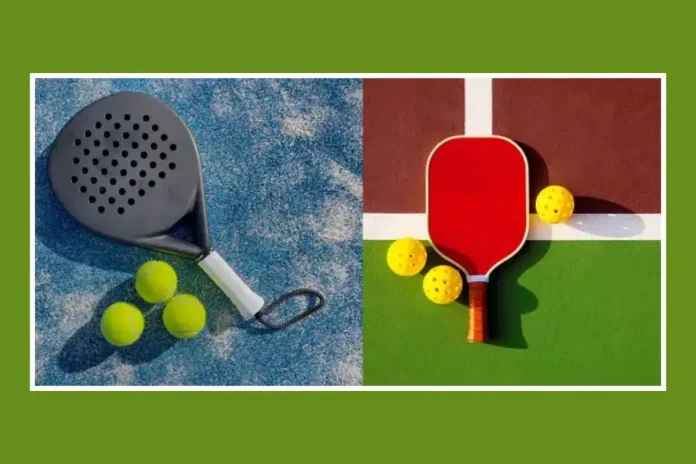Padel vs. Pickleball Comparison 2025: Padel and pickleball are two of the fastest-growing racket sports worldwide, attracting millions of new players in 2025. Both games share tennis-like rallies and simple scoring systems but differ in court size, equipment, and style of play. Pickleball has already passed 19 million U.S. players in 2024, while padel continues to expand rapidly in Europe and Latin America.
What Is Padel
Padel mixes tennis and squash and is played on a 20-meter by 10-meter enclosed court with glass and mesh walls. The walls remain in play after the ball bounces, creating longer rallies. The net stands 0.88 meters at the center and 0.92 meters at the posts. Doubles is the main format, while singles is rare and played on a narrower 20-meter by 6-meter court. Scoring follows traditional tennis rules, including games, sets, and tiebreaks. Players serve underhand after letting the ball bounce and can use the walls during rallies.
What Is Pickleball
Pickleball takes place on an open 44-foot by 20-foot court with a 7-foot non-volley zone, known as the kitchen, on each side of the net. The net height is 36 inches at the sidelines and 34 inches at the center. Both singles and doubles are popular. Players serve underhand or use a drop-serve, and the ball must bounce once on each side before volleys. USA Pickleball rules use side-out scoring to 11 points, with a win by two.
Courts and Equipment
Padel courts are about two-thirds the size of a tennis court and feature glass walls that keep the ball in play. Pickleball courts are roughly one-quarter the size of a tennis court and have no walls but include a 7-foot kitchen to limit net play. Padel players use a solid, stringless racket with holes, no longer than 45.5 centimeters, made of carbon fiber, fiberglass, or foam. Padel balls are pressurized and slightly less bouncy than tennis balls. Pickleball players use a solid paddle no longer than 17 inches, and the combined length and width must be under 24 inches. Balls are made of hard plastic with 26 to 40 holes, with 40-hole balls used outdoors.
Gameplay Style
Padel games feature underhand serves that must bounce before contact. The glass walls allow players to keep rallies alive and add tactical options such as lobs and counterattacks. Pickleball games use an underhand volley-serve or drop-serve. The two-bounce rule slows early exchanges, and the kitchen forces soft play and dinking before aggressive shots.
Choosing a Sport
Players who enjoy tennis or squash may prefer padel for its long rallies and wall rebounds. Those looking for a smaller court, quick starts, and a focus on precision may favor pickleball. Both sports encourage social play and doubles action, making them appealing to families and new players.
Why It Matters
Padel and pickleball are changing the landscape of recreational sports. Their easy rules, social nature, and fast-paced action attract players of all ages. With pickleball booming in the United States and padel spreading worldwide, both games are likely to keep growing and inspiring new athletes in the coming years.
News in Brief: Padel vs. Pickleball Comparison 2025
Padel and pickleball are fast-growing racket sports with different courts, equipment, and scoring. Padel uses a glass-walled court and tennis-style scoring, while pickleball uses an open court, plastic ball, and games to 11. Both sports are easy to learn, social, and popular with new players worldwide.
ALSO READ: Game-Changing Pickleball Paddles: Discover the Top Picks Pros and Beginners Swear By

